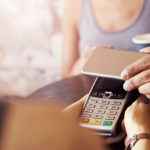Near Field Communications (NFC) payments via mobile phones are now a reality
Near Field Communication (NFC) technology enables wireless communication between two electronic devices that are close to each other. This form of data exchange is not new – it first began to be used in 2002, although it wasn’t until 2016 and 2017 that many brands, banks and organizations included it in their business models. This has led to major advances in contactless and mobile payment methods, based on this technology.

This form of communication between devices inherits its distance and data transmission speed from radio frequency identification (RFID) tags. These tags are the alarms that clothing stores detect in their security controls. The first brand to see their potential was Nokia, which together with Philips and Sony, in 2004 established the NFC forum, is a non-profit association set up to share experiences, applications and solutions for an NFC environment. It began with only three members, but now includes more than 170 brands and companies.
NFC technology has a number of benefits over traditional cash or card payments. The first is security, which is ensured by the proximity between the devices (it only works within a distance 10 to 15 centimeters); and the second, the high transmission speed used to send and receive data (it’s a method that’s almost instantaneous).
Cell phones and cards alike can use this technology for contactless payments, but there is an element of competition between these methods. Cards are more autonomous (they have no battery to charge) and until recently, they were considered more reliable for older users. Cell phones, on the other hand, are always close to consumers and do not require an ATM to check the payment (automatic notifications can be sent). It’s also possible to have several accounts, or “wallets.” in a single device. The only thing missing from the NFC equation that would make smartphones win the battle is for all smartphone models to incorporate the technology. However, the list of smartphones that do have NFC technology is already quite long.
Smartphones: NFC technology’s ally
The main card distributors offered their first contactless card in 1994. Several years later, contactless credit and debit cards made their way to the market. Although society seemed unsure about the security of this method, banks began offering this type of bank card to their customers. Currently, nearly all banks offer them in the countries where they operate.
However, it wasn’t until 2006 when the world’s biggest smartphone manufacturers started to see the possibility of incorporating NFC into their mobile devices. At the time, just 10% of smartphones were used to make payments in stores and large operators focused their efforts on contactless credit and debit cards, putting aside its integration into mobile devices. One of the reasons was the digital gap between youth and older adults who did not own smartphones.
However, once this gap began to close, users became concerned about the security of NFC payments, even though this concern is not justified. Data is encrypted through a token that reaches the NFC reader, which decrypts and interprets this token. Furthermore, most applications require a PIN to confirm the payment and the invoice are issued immediately.
The future of NFC technology is already at hand
Contactless payments have progressed exponentially since 2014. According to forecasts by the GSM Association (GSMA), NFC payments are expected to reach $1.3 billion globally this year. However, this payment method is just one of the many possible uses of NFC. The founder of Biofoundry installed a chip in his thumb last year in order to pay without having to bring along a wallet or smartphone.
In other areas, Nintendo has revolutionized its consoles by incorporating this system into its 3DS, WII U and Nintendo Switch games. NFC can also be used on social networks like Facebook and Linkedin, which uses NFC tags that work like business cards.
In the U.S., public transportation in New York City or the Los Angeles metro already use NFC payments, as do transportation systems in Germany and Canada. In Spain, all the major banks have a “wallet” that uses contactless networks. And tech companies have their own NFC-based payment models: Android Pay and Apple Pay. NFC technology continues to grow around the world and it’s only a matter of time before more and more brands begin to include NFC in their business models.